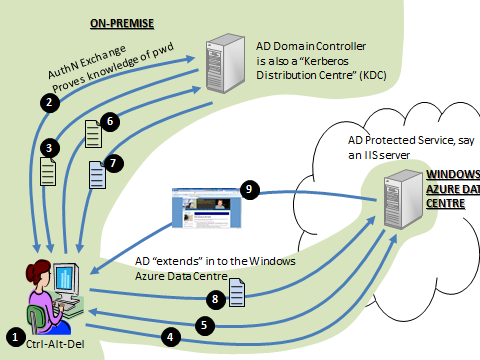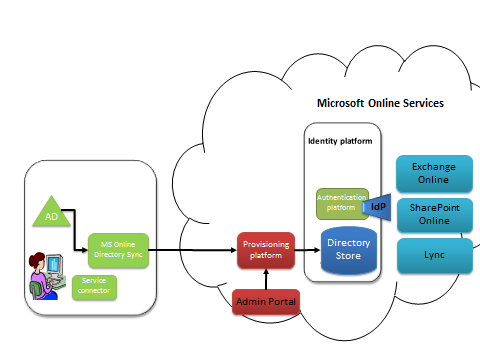A lot of people don’t realize there will be 2 very interesting features in Office 365 which makes connecting the dots with your on-premise environment and Windows Azure easy. The 2 features are directory sync and federation. It means you can use your AD account to access local apps in your on-premise environment; just like you always have. You can also use the same user account and login process to access Office 365 up in the cloud, and you could either use federation or a domain-joined application running in Azure to also use the same AD account and achieve single-sign-on.
Extending the model to the cloud
Windows Azure Connect (soon to be released to CTP) allows you to not only create virtual private networks between machines in your on-premise environment and instances you have running in Windows Azure, but it also allows you to domain-join those instances to your local Active Directory. In that case, the model I described above works exactly the same, as long as Windows Azure Connect is configured in a way to allow the client computer to communicate with the web server (which is hosted as a domain-joined machine in the Windows Azure data centre). The diagram would look like this and you can followed the numbered points using the list above:

Diagram 2: Extending AD in to Windows Azure member servers
Office 365
Office 365 uses federation to “extend” AD in to the Office 365 Data Centre. If you know nothing of federation, I’d recommend you read my federation primer to get a feel for it.
The default way that Office 365 runs, is to use identities that are created by the service administrator through the MS Online Portal. These identities are stored in a directory service that is used by Sharepoint, Exchange and Lync. They have names of the form:
planky@plankytronixx.emea.microsoftonline.com
However if you own your own domain name you can configure it in to the service, and this might give you:
…which is a lot more friendly. The thing about MSOLIDs that are created by the service administrator, is that they store a password in the directory service. That’s how you get in to the service.
Directory Synchronization
However you can set up a service to automatically create the MSOLIDs in to the directory service for you. So if your Active Directory Domain is named plankytronixx.com then you can get it to automatically create MSOLIDs of the form planky@plankytronixx.com. The password is not copied from AD. Passwords are still mastered out of the MSOLID directory.

Diagram 3: Directory Sync with on-premise AD and Office 365
The first thing that needs to happen, is that user entries made in to the on-premise AD, need to have a corresponding entry made in to the directory that Office 365 uses to give users access. These IDs are known as Microsoft Online IDs or MSOLIDs. This is achieved through directory synchronization. Whether directory sync is configured or not – the MS Online Directory Service (MSODS) is still the place where passwords and password policy is managed. MS Online Directory Sync needs to be installed on-premise.
When a user uses either Exchange Online, Sharepoint Online or Lync, the Identities come from MSODS and authentication is performed by the identity platform. The only thing Directory Sync really does in this instance is to ease the burden on the administrator to use the portal to manually create each and every MSOLID.
One of the important fields that is synchronised from AD to the MSODS is the user’s AD ObjectGUID. This is a unique immutable identifier that we’ll come back to later. It’s rename safe, so although the username, UPN, First Name, Last Name and other fields may change, the ObjectGUID will never change. You’ll see why this is important.
Read the complete article @> Single-sign-on between on-premise apps, Windows Azure apps and Office 365 services. - Plankytronixx - Site Home - MSDN Blogs
Published on: .